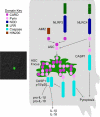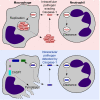Caspase-1-induced pyroptotic cell death
- PMID: 21884178
- PMCID: PMC3609431
- DOI: 10.1111/j.1600-065X.2011.01044.x
Caspase-1-induced pyroptotic cell death
Abstract
Programmed cell death is a necessary part of development and tissue homeostasis enabling the removal of unwanted cells. In the setting of infectious disease, cells that have been commandeered by microbial pathogens become detrimental to the host. When macrophages and dendritic cells are compromised in this way, they can be lysed by pyroptosis, a cell death mechanism that is distinct from apoptosis and oncosis/necrosis. Pyroptosis is triggered by Caspase-1 after its activation by various inflammasomes and results in lysis of the affected cell. Both pyroptosis and apoptosis are programmed cell death mechanisms but are dependent on different caspases, unlike oncosis. Similar to oncosis and unlike apoptosis, pyroptosis results in cellular lysis and release of the cytosolic contents to the extracellular space. This event is predicted to be inherently inflammatory and coincides with interleukin-1β (IL-1β) and IL-18 secretion. We discuss the role of distinct inflammasomes, including NLRC4, NLRP3, and AIM2, as well as the role of the ASC focus in Caspase-1 signaling. We further review the importance of pyroptosis in vivo as a potent mechanism to clear intracellular pathogens.
© 2011 John Wiley & Sons A/S.
Figures


Similar articles
-
Involvement of the AIM2, NLRC4, and NLRP3 inflammasomes in caspase-1 activation by Listeria monocytogenes.J Clin Immunol. 2010 Sep;30(5):693-702. doi: 10.1007/s10875-010-9425-2. Epub 2010 May 20. J Clin Immunol. 2010. PMID: 20490635 Free PMC article.
-
Cytokine Secretion and Pyroptosis of Thyroid Follicular Cells Mediated by Enhanced NLRP3, NLRP1, NLRC4, and AIM2 Inflammasomes Are Associated With Autoimmune Thyroiditis.Front Immunol. 2018 Jun 4;9:1197. doi: 10.3389/fimmu.2018.01197. eCollection 2018. Front Immunol. 2018. PMID: 29915579 Free PMC article.
-
Critical role of ASC inflammasomes and bacterial type IV secretion system in caspase-1 activation and host innate resistance to Brucella abortus infection.J Immunol. 2013 Apr 1;190(7):3629-38. doi: 10.4049/jimmunol.1202817. Epub 2013 Mar 4. J Immunol. 2013. PMID: 23460746
-
Inflammasome-dependent Mechanisms Involved in Sensing and Restriction of Bacterial Replication.Curr Issues Mol Biol. 2018;25:99-132. doi: 10.21775/cimb.025.099. Epub 2017 Sep 6. Curr Issues Mol Biol. 2018. PMID: 28875942 Review.
-
Of inflammasomes and pathogens--sensing of microbes by the inflammasome.EMBO Mol Med. 2013 Jun;5(6):814-26. doi: 10.1002/emmm.201201771. Epub 2013 May 13. EMBO Mol Med. 2013. PMID: 23666718 Free PMC article. Review.
Cited by
-
Novel Virulence Role of Pneumococcal NanA in Host Inflammation and Cell Death Through the Activation of Inflammasome and the Caspase Pathway.Front Cell Infect Microbiol. 2021 Mar 11;11:613195. doi: 10.3389/fcimb.2021.613195. eCollection 2021. Front Cell Infect Microbiol. 2021. PMID: 33777832 Free PMC article.
-
Apoptosis and necrosis in the liver.Compr Physiol. 2013 Apr;3(2):977-1010. doi: 10.1002/cphy.c120020. Compr Physiol. 2013. PMID: 23720337 Free PMC article. Review.
-
Extracellular acidosis is a novel danger signal alerting innate immunity via the NLRP3 inflammasome.J Biol Chem. 2013 May 10;288(19):13410-9. doi: 10.1074/jbc.M112.426254. Epub 2013 Mar 25. J Biol Chem. 2013. PMID: 23530046 Free PMC article.
-
Pannexin1 as mediator of inflammation and cell death.Biochim Biophys Acta Mol Cell Res. 2017 Jan;1864(1):51-61. doi: 10.1016/j.bbamcr.2016.10.006. Epub 2016 Oct 11. Biochim Biophys Acta Mol Cell Res. 2017. PMID: 27741412 Free PMC article. Review.
-
DJ-1 affects oxidative stress and pyroptosis in hippocampal neurons of Alzheimer's disease mouse model by regulating the Nrf2 pathway.Exp Ther Med. 2021 Jun;21(6):557. doi: 10.3892/etm.2021.9989. Epub 2021 Mar 26. Exp Ther Med. 2021. PMID: 33850529 Free PMC article.
References
Publication types
MeSH terms
Substances
Grants and funding
LinkOut - more resources
Full Text Sources
Other Literature Sources
Miscellaneous

